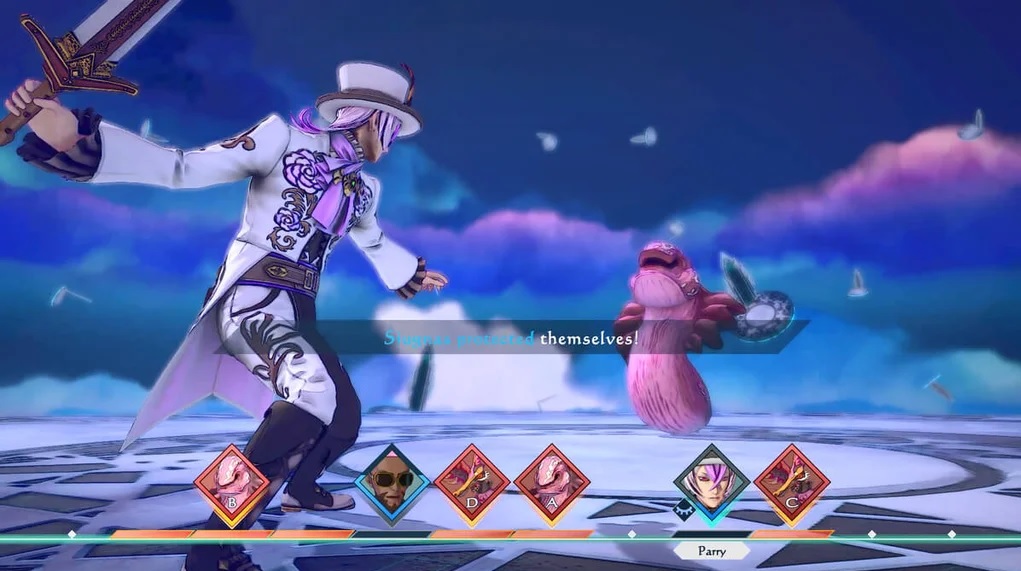
SaGa is one of the longest-running RPG series. Many fans claim that Final Fantasy II, 36 years ago, was the first game in the series, with one of the main designers being SaGa series creator Akito Kawazu. The first SaGa game (known as Final Fantasy Legend in North America) was released for the Game Boy just a year later. In recent years, a succession of new releases has brought new fans to the series, with the latest installment, SaGa Emerald Beyond, positioning itself as the first new installment for many players. I got into the series in early 2024 and played eight SaGa games in two months. Here’s what I knew when I played SaGa: Emerald Beyond: I’m a huge fan of the series by now, the previous game in the series was one of my least favorite games, and while SaGa Emerald Beyond seemed to get back on track, there was a lot to it. The parts I loved about SaGa Scarlet Grace remain intact. And yet SaGa Emerald Beyond surprised me, in both good and bad ways.
In SaGa Emerald Beyond, you can choose from six main characters (two of which are duos). They’re a diverse bunch, including a former singer, a mechanic, a cop buddy duo (one of whom wears a hijab and one who’s a victorious one). It’s inclusive!), a vampire king, a puppeteer, and a witch who can change her age at will. Each one offers a different story and focuses on a unique way to play the game. Siugnas leads a group of vampire slaves and knights who can learn the art of sanguine, while Ameya, unlike the other protagonists, focuses on casting spells (and can collect cats). No matter who you choose, everything is linear at first until you reach the crossroads between worlds and notice a wave of emeralds. From the crossroads, several worlds open up to explore and achieve the current protagonist’s goals (such as collecting cats as mentioned above).
Each world is unique with a large theme, from endless deserts filled with derelict machines to space stations exploring the mysteries of the universe. Fans can expect numerous references to previous SaGa games. Exploration is done from a top-down view, with interactive locations looking like paper cutouts. The Emerald Wave shows all the events and battles available in the current world. Events are short, static conversations between avatars set against a background. Unlike previous entries in the series, there are no dungeons to explore, only minimal voice acting, and the excellent soundtrack feels like it’s been barely used. The whole thing looks pretty minimalistic, at least until you get into combat.

The basic combat framework is the same as in Saga Scarlet Grace. Each round of combat has a pool of stars called Battle Points (BP) that can be spent on actions. The group shares the BP pool, and each character can only take one action per turn. Different techniques and spells also cost different amounts of BP. Characters that don’t spend BP will automatically defend instead. So if you start your turn with 5 BP and have a party of 5 different characters, you can split your turn by using one technology or spell for 1 BP per character. Alternatively, you can spend all 5 BP on a technology for one character, or anything in between. Technologies and spells that cost more BP may be more powerful, but you may or may not want to use different abilities for various reasons. At the heart of combat in SaGa Emerald Beyond is not just choosing the attack that will do the most damage. It’s about manipulating the timeline. The timeline shows the order of actions for the round for both allies and enemies. Techniques and spells allow you to move forward or backward through the timeline, influencing the timing of actions. At the most basic level, this helps you act before your opponents do, but SaGa Emerald Beyond goes a step further (heh). Each technique and spell appears in a box below the timeline. When two or more characters’ boxes overlap, a combo will be performed during the round. Combos grant damage multipliers, and if the multiplier exceeds 150%, you may even activate overdrive for an extra attack. Combos are powerful and can easily change the fate of your party. A good combo can be the difference between wiping out an enemy before they can attack, or doing very little damage. Due to the importance of combo actions, it may be better to use weaker technologies to ensure your characters can participate in a combo even if they have BP remaining. Enemies can also perform combos. Therefore, it is in your best interest to perform actions that disrupt your enemy’s combo. If this were the only means to fight, it would be immediately compelling, but let’s change gears and talk about conditional techniques.
Conditional techniques only trigger under certain conditions. These range from interrupting an attack type, to chaining one action into another, to countering an attack. Techniques and spells with the “suppress” property can confuse the situation (for you and your opponent), adding another layer to the thought process needed to win a battle. But somehow there’s more to it than that!

The majority of this review focuses on combat, which is to be expected as it’s what SaGa Emerald Beyond is all about. Battles are frequent, long and mentally taxing, but they’re fun, challenging and look spectacular in motion; the animations for my favorite attacks never get old. Mr. S (from SaGa II) also returns, providing combat trials that you can complete to earn rewards. These are great for flexing your muscles or trying something new while fighting. The combat system is truly the highlight of the series and one of the best in the genre.
SaGa is known for being tricky, challenging, addictive, replayable, and unlimited, something that is not true of most RPGs. SaGa Emerald Beyond lives up to all these expectations, but not always exactly as you would expect. SaGa Emerald Beyond has the most comprehensive tutorial in the series’ history. That doesn’t mean it’s not challenging, but it does give players more opportunities to learn how to deal with the difficulties in the game. So even if you’re worried about difficulty or a lot of friction, it might be worth giving it a try.
It’s also an incredibly open and non-linear game, but it doesn’t seem that way. Everything you do in SaGa Emerald Beyond counts as a decision on an invisible level. Did you choose to talk to this person before talking to that one? Did you go to this world before that one? Did you fight this battle without continuing the main story? All of these can affect the progression of the story. However, as you follow the waves of emeralds through events and battles, you rarely see more than one option at a time, and in fact the game feels linear even if two players have completely different playthroughs. In subsequent playthroughs, the true vastness of the world begins to shine as you choose new characters or replay characters. The same world can feel completely different depending on your previous actions. It’s a pity that, perhaps at first play, you don’t realize the ambition shown here.

The game does a lot to encourage repeat playthroughs. Not only do the story and combat you face change, but you can keep your gear and other progress throughout your playthrough, making casual playthroughs even quicker. Your first playthrough might take more than a weekend, but a repeat playthrough might only take an afternoon.
Saga Emerald Beyond wasn’t what I expected. When I saw the first trailer, I thought this was Saga Scarlet Grace with a bigger budget and the return of many popular series elements. I even thought it might be the most SaGa-like SaGa game ever. If anything, it feels different to SaGa Scarlet Grace. I’m glad that many of the crazy elements of SaGa are back, but I really miss being able to traverse dungeons, go into shops, and talk to townspeople. Even if SaGa Emerald Beyond didn’t resonate with me that much, I can’t deny the genius of its addictive combat system and the creativity of the developers. I don’t think SaGa Emerald Beyond will convince people who didn’t like the series to try it again, but it’s worth playing for both fans and potential fans.

Leave a Reply